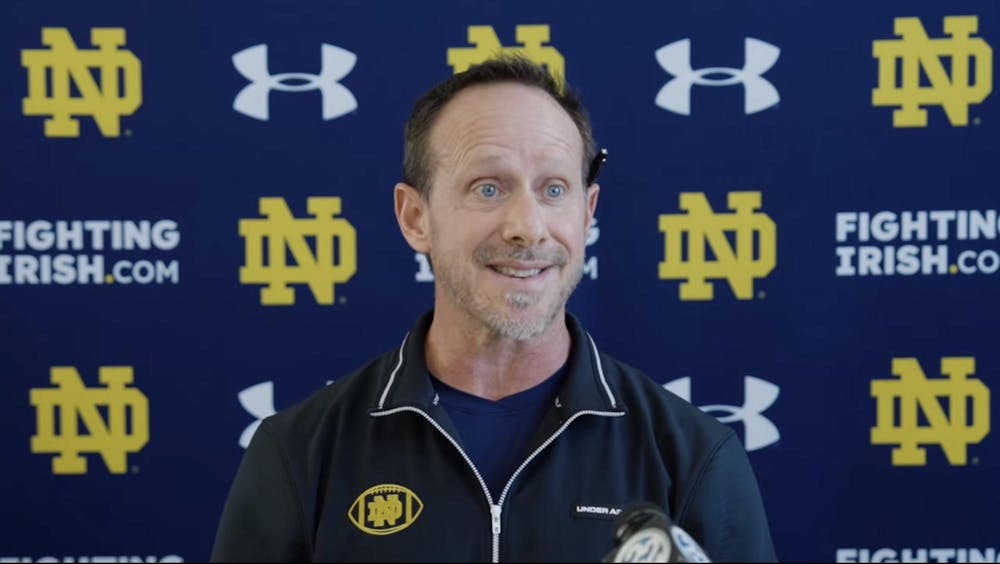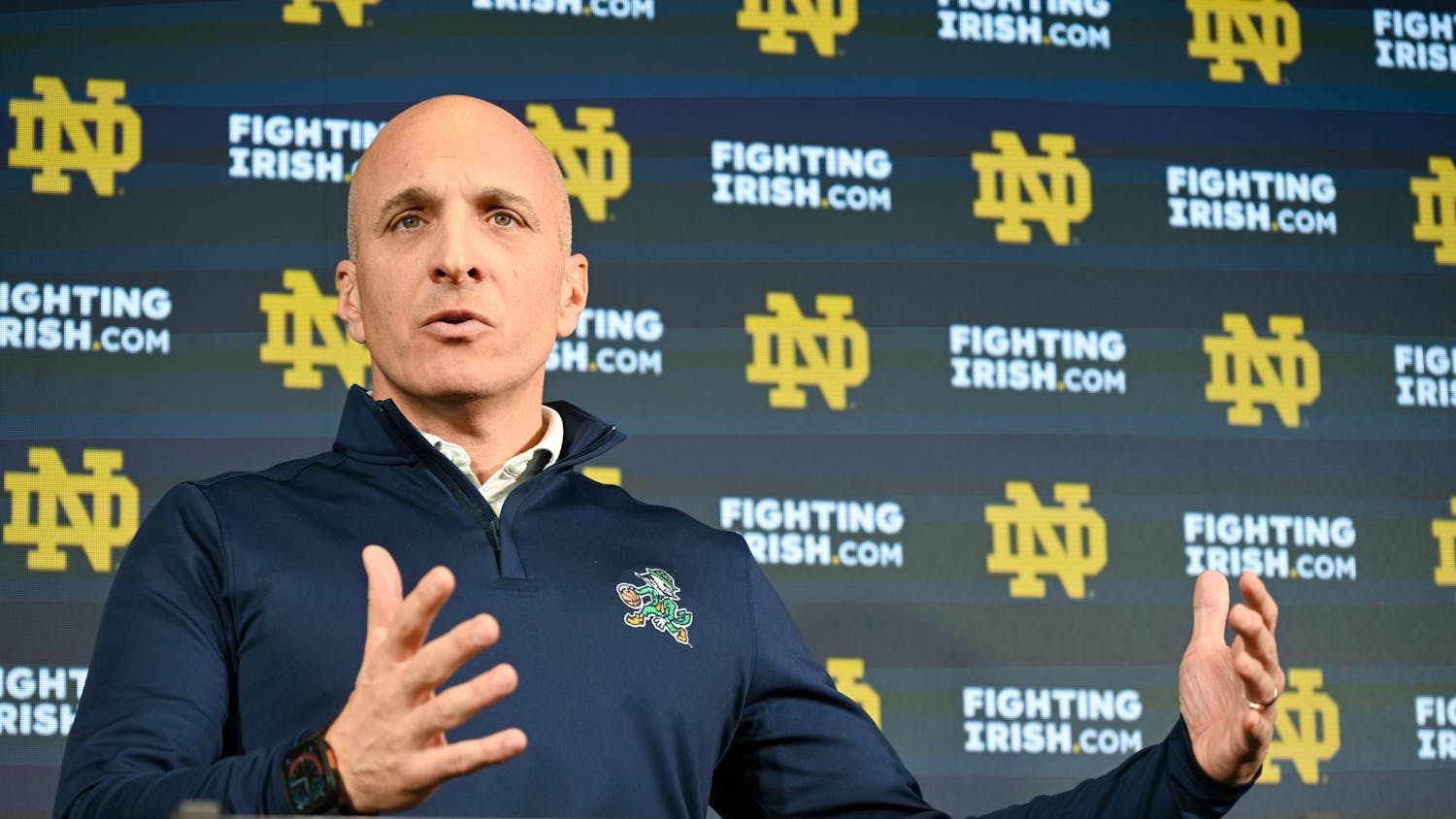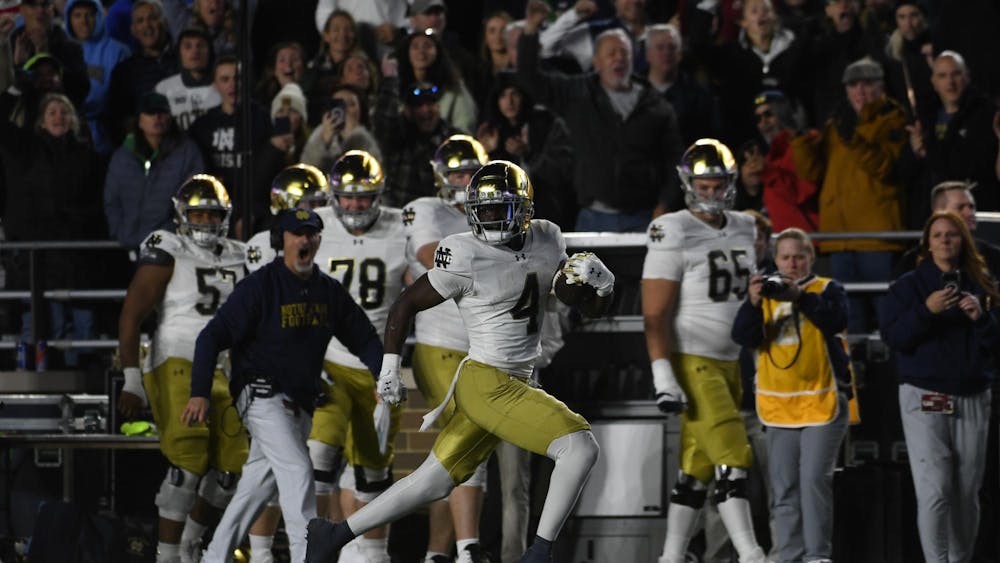Crimson and white confetti fluttered from the rafters of Sun Life Stadium to the verdant Bermuda grass below while the Million Dollar Band blared the heavy brass anthem “Yea, Alabama,” reverberating throughout the stadium and filling the streets of the surrounding Miami suburbs. Once the stream of confetti tapered off and the band concluded playing with a triumphant drumroll, Crimson Tide head coach Nick Saban flashed a rare smile and triumphantly raised a crystal football trophy to celebrate his fourth national championship following a 42-14 beatdown of Notre Dame. This embarrassing defeat grew even more humiliating after Irish players made comments reminiscent of a Daft Punk song, describing the Alabama linemen as harder hitters, better competitors, faster athletes and stronger football players.
“[Alabama offensive linemen] D.J. Fluker and Chance Warmack come running out of the locker room, and they had their shirts pulled up,” said former Notre Dame linebacker and captain Manti Te’o. “I remember silence behind me. I glanced back at my teammates, and the eyes on them were so large. I knew at that time this is going to be a long day.”
Though the end date of the 5,162-year-long cycle in the Mayan calendar did not coincide with the apocalypse at the close of 2012, perhaps it did foretell the demise of Notre Dame football’s status as a championship-level program. But nearly 12 years later, following a convincing victory over Texas A&M at Kyle Field, Notre Dame has its best chance in decades to end a 36-year national title drought, due in large part to new strength and conditioning coach Loren Landow. Landow’s training regimen had the Irish better prepared for the humid Texas heat than the Aggies themselves. By the fourth quarter, the Aggies had lost several starters to severe cramping, and their defense looked visibly exhausted, hands on their hips between snaps while greedily sucking in as much oxygen as possible with each haggard breath. With their improved endurance from Landow’s offseason conditioning program, the Irish remained loose and notched big runs against Texas A&M’s weary defense to secure the win.
Now that the College Football Playoff has expanded to 12 teams, Notre Dame will have to survive a 16-game gauntlet to earn its 12th national championship, making depth and durability more important than ever. As such, Coach Landow’s strength and injury prevention training will also become more important than ever, and there is little doubt he will rise to the occasion. Having worked with elite NFL players and Olympic gold medalists for years, Landow knows what it takes to play like a champion.
Notre Dame’s size and strength didn’t come in the form of an overnight growth spurt. Former head coach Brian Kelly fought to stave off the 2012 apocalypse by drastically overhauling the team’s recruiting strategy to target bigger, stronger personnel. In the following seasons, the Irish built around the trenches, producing elite NFL talent the likes of Quenton Nelson, Ronnie Stanley and, most recently, Joe Alt. Despite this sustained success earning Notre Dame the nickname “Offensive Line U,” something feels different about the Irish linemen this season, with many players making the proverbial leap.
Even ESPN analyst Kirk Herbstreit noticed these drastic improvements, saying, “[Notre Dame] used to always have big linemen, big tight ends, big d-linemen, big linebackers, but with their skill, it just looks different. They’re long — they’re bouncing, athletic guys.”
“They’re a team that’s going to be in the playoff without a doubt,” Herbstreit said.
This rapid improvement over such a short period of time can largely be attributed to Landow’s offseason workouts, which began promptly after his hiring on Dec. 19, 2023. Once football season ends, there are dead periods during which head coach Marcus Freeman is prohibited from contact with the players or times when he’s stretched too thin by the recruiting calendar. That’s when Landow steps in and serves as the de facto head coach, meticulously planning lifting sessions down to the second. These winter workouts are especially important for early enrollee freshmen, helping them acclimate to the schedule of a Notre Dame student-athlete and strengthen their bodies to withstand the rigor of a full collegiate football season.
“The biggest thing we talk to [the early enrollees] about is to learn our process, learn what we do here, how we’re going to do things. It’s not about what you do but how you do it,” Landow said.
“I told all of them, you know, I’m sharpening the ax right now, and then we go cut down the tree. Technical proficiency is absolutely the number one priority.”
Early enrollee freshman left tackle Anthonie Knapp took these lessons to heart, wielding his sharpened ax with technique and precision during each lifting session to gain 25 pounds in five months. To improve flexibility and correct range-of-motion issues, Landow would have Knapp and the other linemen train barefoot to correct imbalances in quads or hamstrings. A season-ending torn pectoral injury to sophomore left tackle Charles Jagusah thrust Knapp into the starting lineup and guaranteed a showdown with elite pass rusher Nic Scourton in College Station. Now weighing in at 294 pounds, Knapp flashed his immense potential in a strong first start. He excelled in pass protection, allowing just one pressure on 36 pass-block snaps, shutting down and frustrating Scourton so much the Aggies flipped him to the opposite side of the field only to get stonewalled by junior right tackle Aamil Wagner, another beneficiary of Landow’s weight program.
“[Coach Landow] helped me tremendously. He’s met me where I’m at,” Wagner said.
“He knows even though I’m a lineman, I’m not the typical lineman. He’s just working me daily, whether it’s stretching, flexibility, weight training, whatever it is, he’s done a great job with breaking down individual plans and I’m thankful for it.”
Prior to his arrival in South Bend, Landow owned and operated Landow Performance in Centennial, Colorado. From Christian McCaffrey to Missy Franklin, each wall in the facility is covered in framed jerseys and memorabilia from some of the 700 professional athletes Landow trained in the NHL, MLB, UFC, WNBA and NFL, including more than 20 NFL Draft first-round picks. He joined the Denver Broncos staff as head strength and conditioning coach in 2018, helping safety Justin Simmons grow from a mid-round pick to a four-time All-Pro and team captain.
Simmons improved his game by first improving his training. After running a diagnostic on his training technique, Landow determined Simmons had improper squatting technique. The safety lifted with his feet too wide and toes angled out, putting unnecessary pressure on his knees and back that contributed to season-ending injuries during his first two years in the league. After Landow corrected this improper lifting technique, Simmons didn’t miss a snap for over two seasons, turning availability into productivity and a four-year, $61 million contract extension.
Landow combines old school motivation with new school sports science, emphasizing flexibility, deceleration and body control to prevent injuries while developing specific routines for each player. These training techniques help protect against soft tissue injuries, which could help prevent a repeat of last season when Irish receivers suffered a string of hamstring injuries that left the team with just three healthy scholarship wideouts by the end of September. Though they would see the field again, those receivers never fully recovered, preventing Sam Hartman and the Irish offense from fully recovering, too.
After Broncos head coach Sean Payton cleared house and dismissed all supporting staff, Landow returned to his training facility to reset and return to basics. During that time, he remained in contact with many of his former players like Simmons and former Irish offensive lineman Mike McGlinchey. Landow also reconnected with another former player, legendary Notre Dame quarterback Brady Quinn. Landow helped Quinn rehab from his Lisfranc surgery after being traded from the Cleveland Browns to the Broncos. Landow also trained Quinn’s future wife, U.S. gymnast and Olympic silver medalist Alicia Sacramone.
During one of their many conversations, the topic of Notre Dame football’s vacant strength and conditioning position arose, leading to Landow expressing his interest in joining the storied tradition of the Fighting Irish.
“The question that was asked to me in the interview process was ‘why college football?’ And I said, ‘Well, it’s Notre Dame,’” Landow said.
“I love working with athletes of all levels, but I think the thing that intrigues me with college is the ability to develop. Having the time to develop them is key.”
Quinn advocated for Landow’s hiring to Coach Freeman throughout the season and facilitated conversations between the two coaches after the end of the regular season. Ultimately, Landow said he couldn’t turn down the opportunity to join the legendary Notre Dame program while Freeman couldn’t resist hiring a proven strength coach who helped such varied athletes excel at the highest level of their respective sports.
“I was told when I got here I was going to get a hardworking group, a good group of smart kids,” Landow said.
“They’ve bought in. They want to hear about those guys at the professional level and what they do specifically. They listen to coaching and that’s been the biggest thing I’ve been looking for.”
Just as the players have bought into Landow’s culture, he has bought into Notre Dame’s. He says he’s here for the long run, eager to oversee player development for years to come. While already successful in his first year, his strength and agility training will only grow more successful in subsequent years. Youthful linebackers Jaylen Sneed and Jaiden Ausberry, though already talented contributors, could become the cornerstones of the Irish defense after a year or two adding muscle in Landow’s program.
Landow’s expertise across multiple sports could even help inform where Notre Dame puts its resources for the new Shields Family Hall training facility, keeping the program on the cutting edge of sports science and recovery to ensure that this time, the Irish will be the team playing harder, better, faster and stronger in the national championship game.









